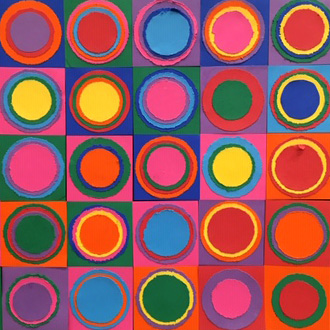Curriculum
Primary Curriculum
Throughout the primary curriculum the children engage in hands-on learning, using developmentally appropriate, concrete, multi-sensory, self-correcting Montessori materials. The curriculum is followed by children from 2.9 to 7 years old and each child has an individualized learning plan and is guided and supported through each school year.
Language
The social language needs of the child are met through conversation and verbal communication between the child, its’ peers and with the teachers as well as by listening and taking part in conversations and discussions at home. In the classrooms all children are exposed to a wide variety of literature and there are many opportunities to look at books, be read to by the teachers and to read independently, thus expanding and enriching vocabulary.
To help prepare the child to write and read, there are three factors to take into consideration, physical, mental and social. Exercises such as push pin, stringing, coloring and metal insets are presented, which refine fine motor control and the children are introduced to the tripod pencil grip required by a successful writer.
The children in all the classrooms proceed at their own pace, and working closely with the children the teachers encourage and support each child.
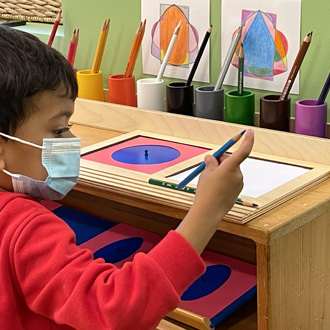
Math
The Montessori Math curriculum moves from the concrete, introducing increasingly abstract concepts and so in small sequential steps, each child develops their own mathematical mind at their own pace.
Dr. Maria Montessori’s teaching method is based on the premise that ‘arithmetic’ should “start with sense perceptions and be based on a knowledge of concrete objects”. With the manipulation of concrete objects within the classroom, the child builds mental concepts of numbers and further refines the ability to concentrate.
Math materials are presented to the children as interest is expressed or observed and then the child may explore the materials repeatedly, until the concept is mastered. Small children naturally love repeating activities and can easily absorb the concepts presented.
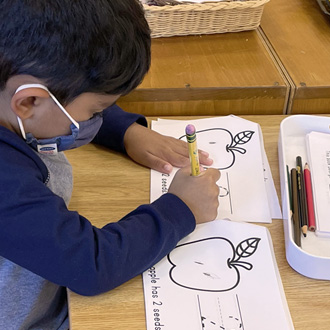
Geography & Cultural Studies
We all inhabit the same earth. Geography lessons help the children become familiar with our earth and develop an understanding of where they are in relation to everyone else. Children study a particular continent or geographic region, learning about animals, peoples, traditions, games, language, homes and foods etc. Land and Water and continent globes all help teach the fundamentals of geography.
Children learn about life in each of the continents.
- Who lives there?
- What do the people eat?
- What animals live there?
- What special places, customs and languages are found there?
- Where do I live?
- How am I connected to the rest of the world
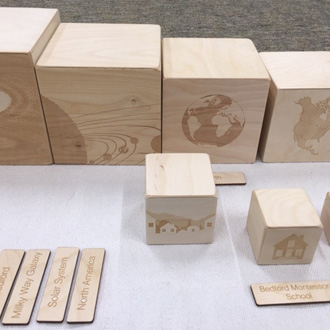
Practical Life
Practical Life activities in the classroom are both intended to attract all age groups within the multi-age classroom and designed for use by children of differing ability levels.
Activities are displayed in sequence from left to right, simple to more complex, progress from using two hands to one hand, to using tools and from concrete to abstract. The choice of work depends on each child but the teacher is available as a guide if required.
Basic hand movements that the children master through repetition of Everyday Living activities will later help them learn to hold a pencil and write and form letters. Completion of tasks from left to right helps the child learn to read. Developing concentration and attention to detail are skills required to complete complex tasks, help the child in number and scientific works and in completing future tasks they may face.
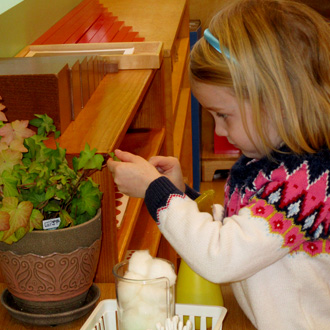
Sensorial
The Sensorial activities in the toddler and primary Montessori classrooms provide an opportunity for each child to interpret the world around them through the use of their senses in a controlled manner, which in turn helps develop their minds. Education of the senses prepares a child’s mind so that it is receptive to other information and can interpret other stimuli correctly.
“This sense training will prepare the ordered foundation upon which he (the child) may build up a clear and strong mentality.”
Dr. Maria Montessori
Each child is presented with the opportunity to explore concepts in a concrete way before moving to work with more abstract theories and models. Language is an important part of all Sensorial lessons and the teachers provide the correct nomenclature as appropriate to help the child ‘fix the idea of a quality’ with a word.
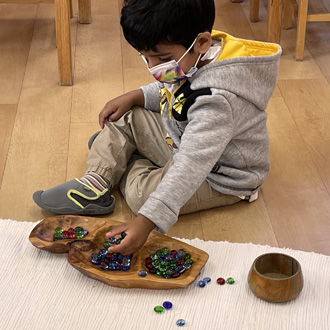
Science
Science activities in the classroom are intended to engage each child’s curiosity and awaken a determination to find the truth for themselves. Children learn how to observe, analyze, predict and document observations. They work with concrete materials where appropriate and learn about the world around them by conducting hands on experiments and explorations and begin to make connections between the classroom works and the world in which they live.
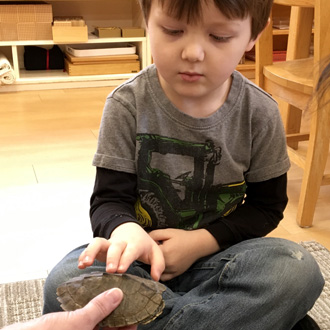
Art & Music
Art and music are not taught as isolated subjects, but are integrated into the life of each classroom in many different forms. Music and art are explored through the context of history and culture as appropriate.
The children are able to express their creativity through a variety of art media available in the classrooms, including pencils, paint, crayons, charcoal, chalk, and clay.
Singing and movement in the primary classrooms are part of everyday classroom life, circle time meetings. Children also listen to and learn about different musical forms and styles – from folk to classical, salsa to rock. In addition all children participate in the music & movement class throughout the year.
